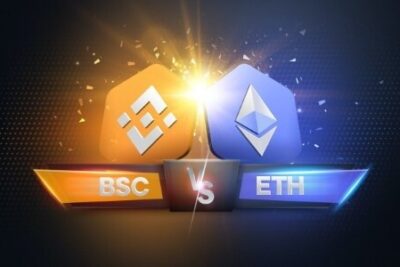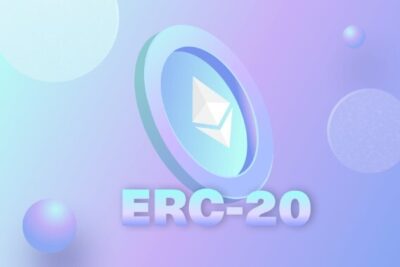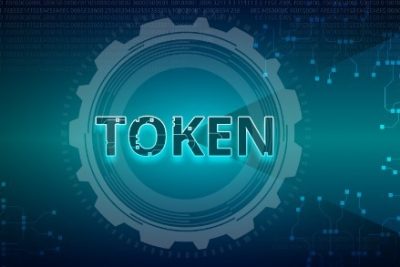

Binance Smart Chain Vs Ethereum – Who Is The Winner In The Blockchain Race?
18 August 2022
Context is essential to comprehending the blockchain battle between Binance Smart Chain vs Ethereum. Bitcoin and its underlying blockchain gave rise to the crypto industry as it is known today. People and organizations subsequently built other assets, blockchains, and applications, thus expanding the crypto industry’s potential and offering individuals further alternatives on the basis of blockchain technology, crypto assets, and solutions function. Developers utilize this technology as the backbone for decentralized applications (DApps) and digital assets.
DApps are simple applications with an easy UI that mimic other computer programs. However, their backends are supported by blockchains or other distributed ledger systems (DLT). Moreover, depending on the commodity, coins or tokens created on blockchains may facilitate transactions and value storage without a third party.
The Binance Smart Chain vs Ethereum blockchains is just two of the several blockchain options accessible to developers.
Is BNB’s Smart Chain more advanced than Ethereum? Is Ethereum more advanced than the BNB Smart Chain? Is the Ethereum blockchain safe? Is the network at BSC secure? Understanding these two blockchains may help readers formulate their opinions on this bePAY topic.
The BNB Smart Chain
BNB Smart Chain is a relatively new blockchain meant for creating decentralized apps with great speed. It was once known as “Binance Smart Chain” but at the start of 2022, it changed its name to dissociate itself from the Binance exchange. The BNB Smart Chain was designed to operate in tandem with the Binance Chain (now the BNB Beacon Chain) and is powered by the BNB coin.
Even though the cryptocurrency has been renamed; once known as Binance Coin, the BNB token is now called “Build & Build” but has the same acronym.
BNB Beacon Chain (previously Binance Chain) was introduced in 2019 to promote quick, decentralized trading. However, its flexibility and scalability are restricted. BSC was a technique to introduce smart contract capability to the Binance ecosystem without generating congestion and affecting network speed.
BSC is an independent blockchain (as opposed to a layer 2 or off-chain scaling solution), if BNB Beacon Chain were to go down for any reason, BSC would continue to operate.
The cross-chain connectivity of BSC and BNB Beacon Chain gives users access to a bigger and more comprehensive ecosystem. Users may simply move their assets from one blockchain to another, trade BSC assets on numerous exchanges, and use them in a vast array of decentralized applications.

Some information about BNB Smart Chain (BSC)
BSC also made a number of astute decisions early on, beginning with its architecture. BSC is compatible with the Ethereum Virtual Machine (EVM), which means it supports Ethereum applications and tools.
This makes it simpler for developers to migrate their projects from Ethereum (should they need to avoid Ethereum’s overloaded network) and for consumers to adopt programs such as cryptocurrency wallets to function with BSC.
The second intelligent decision was to introduce the Binance Smart Chain BUIDL Reward Program to incentivize developers to create decentralized applications on the BSC platform. The incentive scheme provides up to $5 million in BNB to be repaid to developers proportionally to the amount of natural gas consumed in their contracts.
The Ethereum
Vitalik Buterin, a programmer, designed the Ethereum blockchain. Vitalik Buterin envisioned, in the 2014 Ethereum Whitepaper, a blockchain that would provide developers with unlimited freedom to construct whatever application they wanted. Thus, the smart contract was formed in 2015, with Ethereum serving as its vehicle and ether (ETH) as its fuel.
Ethereum introduced a whole new universe of blockchain use case possibilities, including banking, gambling, identity management, and decentralized autonomous organizations (DAOs). The most prevalent use case, however, has been non-fungible tokens, often known as NFTs.
Ethereum is now the most popular option for minting NFTs, but for how much longer? At the beginning of 2021, Ethereum’s NFT market share dropped from 95% to 80%. The change in sales has been attributed to the network’s infamously expensive gas prices.

Some information about Ethereum
>>Take some tips on how to reduce gas fees with Ethereum
However, developers continue to be drawn to the Ethereum network. More than 20% of new Web 3 engineers joined Ethereum, according to the Electric Capital Developer Report (2021).
Solidity (the programming language for constructing Ethereum smart contracts) enables scripting, which is one of the primary reasons dApp developers choose Ethereum over other blockchains.
In addition to tutorials and development tools such as debuggers, unit test frameworks, and test coverage tools, Ethereum offers a comprehensive collection of supporting tools. Now that we are familiar with the history of each blockchain, let’s examine how they vary.
Binance Smart Chain Vs Ethereum: Decentralisation
For good reason, decentralization is one of the cornerstones of blockchain technology. Without it, network security is compromised and a trustless environment is very difficult to achieve. How decentralized can a network be, though?
The greater the number of nodes verifying transactions and confirming blocks, the more decentralized a network is.
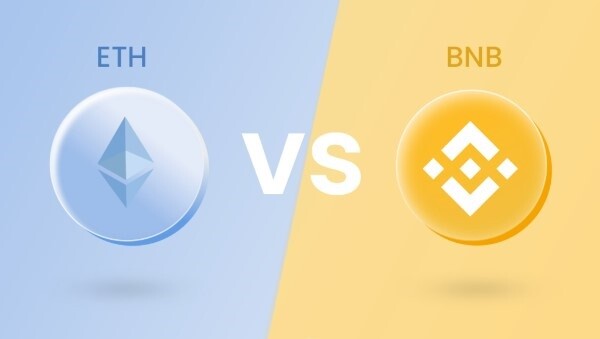
Binance Smart Chain vs Ethereum in terms of decentralization
The Nakamoto coefficient enables the quantification of decentralization. However, this is easier to say than to accomplish. As BSC has just 21 validators, determining the Nakamoto coefficient is straightforward. On the other hand, experts are unable to determine an exact Nakamoto coefficient for the Ethereum network, which has over 300,000 validators.
Nonetheless, it is evident that BSC has a long way to go before it reaches Ethereum’s level and becomes a genuinely decentralized network.
Binance Smart Chain Vs Ethereum: Transaction Fee
Now that we’ve proven the decentralization of both networks, the transaction fees and throughput are the next most essential variables when comparing BSC and ETH.
With almost 3000 decentralized applications, Ethereum processes just 15 transactions per second (TPS). This is excessively sluggish when compared to older networks such as Visa and Mastercard.
Many say that this sluggish transaction processing prevents Ethereum from becoming a global computer and contributes to network congestion. As a consequence, Ethereum suffers from very high transaction fees that may amount to thousands of dollars, rendering the network inaccessible to the typical user.

Binance Smart Chain vs Ethereum in terms of transaction fee
Despite this significant scaling challenge, the Ethereum development community is certain that decentralization and security will not be compromised for speed. Instead, they continue to research and transition from the Proof-of-Work consensus model to the Proof-of-Stake model, which is anticipated to minimize network traffic congestion and transaction costs.
BSC, a competitor to Ethereum, uses a centralized architecture to preserve scalability in terms of higher throughput and reduced transaction costs. BSC is capable of processing up to 300 TPS, and the typical transaction costs just a few cents.
BSC’s TPS rate positioned it as the most viable option for Ethereum network users priced out of the network. BSC also enables users to experience the same DeFi benefits as Ethereum, including composability and high yield, in a low-fee environment. Sadly, this came at the price of genuine decentralization.
Binance Smart Chain Vs Ethereum: Developer Activity
Developer participation is an excellent measure of a robust and appealing environment. Research by Electric Capital stated that 34,000 new developers joined the Web3 ecosystem in 2021, with over 20% joining Ethereum.
The analysis also compares the number of active BSC and Ethereum developers by December 2020 and December 2021, with the results demonstrating Ethereum’s dominant position. In light of the fact that BSC is still in its infancy in terms of functionality, this shouldn’t come as much of a surprise.
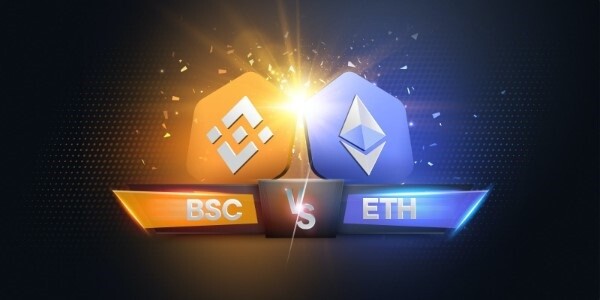
Binance Smart Chain vs Ethereum in terms of developer activity
Changpeng “CZ” Zhao poured over $1 billion into the Binance ecosystem in mid-October 2021 in an effort to promote talent development and developer engagement. In 2021, despite this substantial effort, BSC had around 250 active developers each month.
Overall, Ethereum’s first-mover advantage is undeniable and largely responsible for its appeal among developers. If we include in the impending move to ETH 2.0, BSC may find it much more difficult to match Ethereum’s development effort.
Binance Smart Chain Vs Ethereum: Consensus Model
Consensus models play a significant role in both the security and speed of a blockchain. Proof of Staked Authority (PoSA) is a mixture of the Proof of Authority (PoA) and Delegated Proof of Stake (DPoS) consensus models used by BSC. By integrating the reputation-based consensus algorithm of PoA with the delegation-based voting mechanism of DPoS, BSC is able to achieve high throughput and satisfy user expectations at a cheap cost.
The PoSA consensus methodology is scalable since it only takes 21 validators to operate. For the same reason, though, BSC is vulnerable to security threats such as the 51% attack and hacking by a few validators.
With so few validators, choices are also made by gatekeepers and central authorities. In such centralized settings, the likelihood of unjust treatment, such as asset confiscation and exclusion, is great.
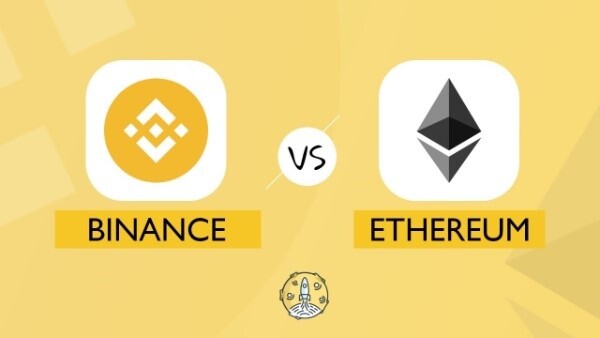
Binance Smart Chain vs Ethereum in terms of consensus model
Ethereum and its consensus architecture are a hot issue, and ETH 2.0 is constantly of interest. In summary, ETH 2.0 signifies a shift from Proof of Work to Proof of Stake (PoS). PoS as a consensus paradigm requires node validators to lock up or stake their assets for the opportunity to issue blocks and process network transactions. Validators are dissuaded from acting maliciously by the possibility of losing their staked assets.
PoS also allows a network to have as many validators as feasible, thereby reducing its susceptibility to intrusions.
Currently, Ethereum utilizes the Proof of Work (PoW) consensus methodology, which is energy-intensive and restricts scalability. With the planned shift anticipated to occur in the second quarter of 2022, however, the scalability and throughput of the Ethereum network will certainly increase.
Ethereum is very unlikely to be able to meet or surpass Binance’s centralized PoSA mechanism in terms of cheap costs and throughput.
Binance Smart Chain Vs Ethereum: Total Value Locked (TVL)
The total value locked (TVL) in the protocol is used as a statistic to monitor the growth of a network. Obviously, this is not a stable statistic, since users frequently transfer value across networks. Nonetheless, TVL serves a role by allowing us to monitor network activities.
When comparing the two blockchains, Ethereum dominates the DeFi ecosystem with over $115.61B in TVL over many EVM-compatible blockchains, whereas BSC has just $12.71B in TVL. Please note that the figures supplied are from the time this article was written and are subject to change periodically.
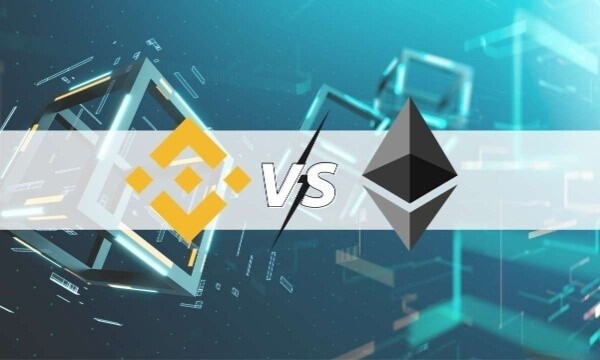
Binance Smart Chain vs Ethereum in terms of TVL
Ethereum’s capacity to employ multiple L2 chains to promote liquidity and composability, as well as its more robust protocols and larger developer environment, all contribute to its remarkable TVL. This is nonetheless insufficient to prevent BSC from outperforming Ethereum in terms of transaction volume.
Binance Smart Chain Vs Ethereum: User Experience
As an Ethereum fork, BSC attracts DeFi developers seeking a cheaper platform by using Ethereum development tools and the massive Binance ecosystem user base. And while being often criticized, BSC demonstrates that most users care little about severe decentralization, which on Ethereum necessitates paying very large gas prices.
DeFi users that want to harvest the highest yields or lend on a permissionless network regularly swarm BSC to get the equivalent of what Ethereum gave customers originally and exclusively. The “bridges” that let users move their assets from one blockchain to another also facilitate the transfer of value to BSC from Ethereum. However, it does not end there!
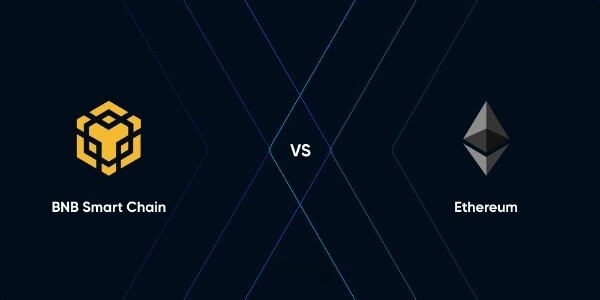
Binance Smart Chain vs Ethereum in terms of user experience
Many cryptocurrency exchanges and protocols do not accept deposits of non-native assets, mostly owing to a lack of integration resources to support every mainnet token. However, by permitting BEP20 deposits, they may automatically support the vast majority of BSC network assets. This makes BSC a cheap and quick option to enroll consumers into the DeFi ecosystem and gives Binance a plug-and-play technology to address the demand for native crypto goods.
Binance Smart Chain vs Ethereum: Network Transfer
If you deposit BEP-20 or ERC-20 into your wallet, you will see that the BCS and Ethereum wallet addresses are identical. Consequently, if you remove tokens from an exchange using the incorrect network, it is simpler to reclaim them from other blockchains.
If you remove ERC-20 tokens from BSC inadvertently, you may still locate them at the matching BSC address. Similarly, if you accidentally transmit tokens from BSC to Ethereum, you may use the same procedure. Your money will remain secure in both instances.
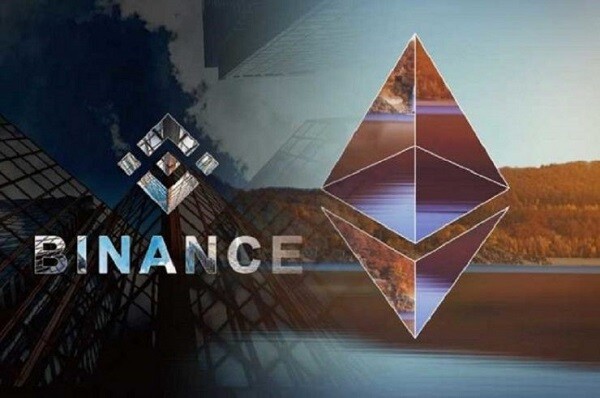
Binance Smart Chain vs Ethereum in terms of network transfer
FAQs About Binance Smart Chain Vs Ethereum
Is BNB Based On The Ethereum Platform Or Something Else?
BNB was previously built on the Ethereum network but is now the native currency of Binance’s own blockchain, the Binance chain. Every quarter, Binance uses one-fifth of its revenues to repurchase and permanently destroy, or “burn,” Binance coins stored in its treasury.
How Fast Is Binance Smart Chain?
As of today, the Binance Smart Chain is currently one of the world’s quickest blockchains. BSC is widely renowned for its lightning-fast transactions. In contrast to Ethereum’s block generation time of 13 seconds, blocks in a Binance Smart Chain are generated every 3 seconds.
Is Binance Smart Chain Cheaper Than Ethereum?
Although BSC is far cheaper and quicker than the Ethereum network, it has a critical flaw that causes institutional finance to approach it with caution for long-term DeFi investments. The degree of centralization of the Binance Smart Chain is very high.
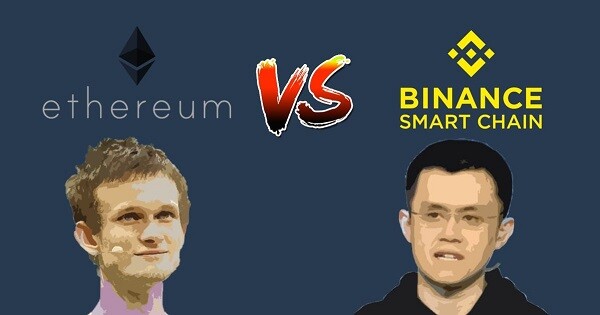
Is Binance Smart Chain cheaper than Ethereum?
Closing Thoughts
BNB Smart Chain expands the capabilities of BNB Beacon Chain and bridges the gap between it and Ethereum through EVM compatibility. Its interoperability, reduced transaction costs, and faster transaction times make BSC a perfect foundation for the development of robust decentralized applications.
Ethereum, on the other hand, is a proven and robust ecosystem that provides a versatile framework for the creation of decentralized applications. Its massive user base is also a significant factor in favor of deploying on Ethereum. If Ethereum 2.0 development continues in the direction of a Proof of Stake consensus technique, network interaction should become much quicker and less expensive.

What Is Taproot Bitcoin? How Does It Affect Bitcoin?
24 June 2022
Step By Step Guide Of How To Add Fantom To MetaMask
15 July 2022
What Is Web 3.0 And How Does It Affect The Future?
16 March 2022